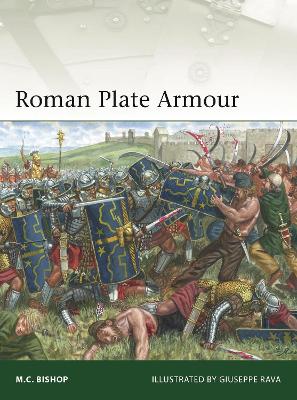Elite
2 total works
The introduction of the scutum in the 4th century BC revolutionized the way the Romans fought. Instead of being purely defensive, the shield became a weapon in its own right. Using the top edge or boss to punch an opponent, or the lower rim to smash down on their feet, it served to unbalance an enemy and allow the sword to do its work. The versatility of the scutum was characterized by the testudo, a formation the Romans used offensively like a pedestrian tank. Meanwhile, other shield types equipped the auxiliaries who fought alongside the legionaries. The curved, rectangular scutum survived into the 3rd century AD, only to be replaced by an oval, slightly domed shield derived from the oval shields of Early Imperial auxiliaries.
Drawing together historical accounts, excavated artefacts and the results of the latest scientific analyses of the boards and fittings, renowned authority M.C. Bishop reveals the development, technology, training and use of the scutum and other Roman shield types.
Drawing together historical accounts, excavated artefacts and the results of the latest scientific analyses of the boards and fittings, renowned authority M.C. Bishop reveals the development, technology, training and use of the scutum and other Roman shield types.
Fully illustrated, this book investigates the articulated plate armour worn by Roman legionaries.
First named by Renaissance historians studying the reliefs on Trajan’s Column, lorica segmentata evaded successful attempts to reconstruct it until a series of important archaeological finds in the 20th century revealed how it worked and the truth of its extended chronology. The earliest finds date from the late 1st century BC, and its discovery at Kalkriese in Germany shows how rapidly it was adopted. At the same time, discoveries in Spain and Britain showed that, despite its apparent fragility, it continued in use into the 4th century AD.
The spectacular find of six halves of cuirasses in a chest at Corbridge in 1964 has now been matched by the rare discovery of a complete set of this armour at Kalkriese. The Corbridge find provided the context to interpret and reconstruct earlier finds. There is now years of experience gleaned from reenactors over the practical strengths and weaknesses of this form of armour. At the same time, scientific analysis has provided insights into the technology behind this revolutionary form of armour so characteristic of the Roman Army. Featuring specially commissioned artwork and drawing upon the latest findings, this study lifts the veil on the formidable plate armour used by the legionaries of Imperial Rome.
First named by Renaissance historians studying the reliefs on Trajan’s Column, lorica segmentata evaded successful attempts to reconstruct it until a series of important archaeological finds in the 20th century revealed how it worked and the truth of its extended chronology. The earliest finds date from the late 1st century BC, and its discovery at Kalkriese in Germany shows how rapidly it was adopted. At the same time, discoveries in Spain and Britain showed that, despite its apparent fragility, it continued in use into the 4th century AD.
The spectacular find of six halves of cuirasses in a chest at Corbridge in 1964 has now been matched by the rare discovery of a complete set of this armour at Kalkriese. The Corbridge find provided the context to interpret and reconstruct earlier finds. There is now years of experience gleaned from reenactors over the practical strengths and weaknesses of this form of armour. At the same time, scientific analysis has provided insights into the technology behind this revolutionary form of armour so characteristic of the Roman Army. Featuring specially commissioned artwork and drawing upon the latest findings, this study lifts the veil on the formidable plate armour used by the legionaries of Imperial Rome.

